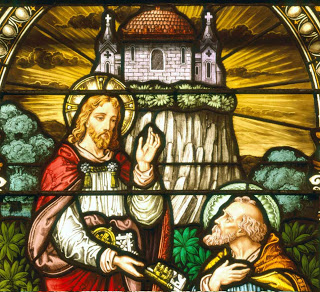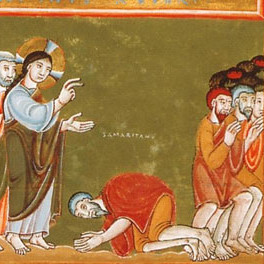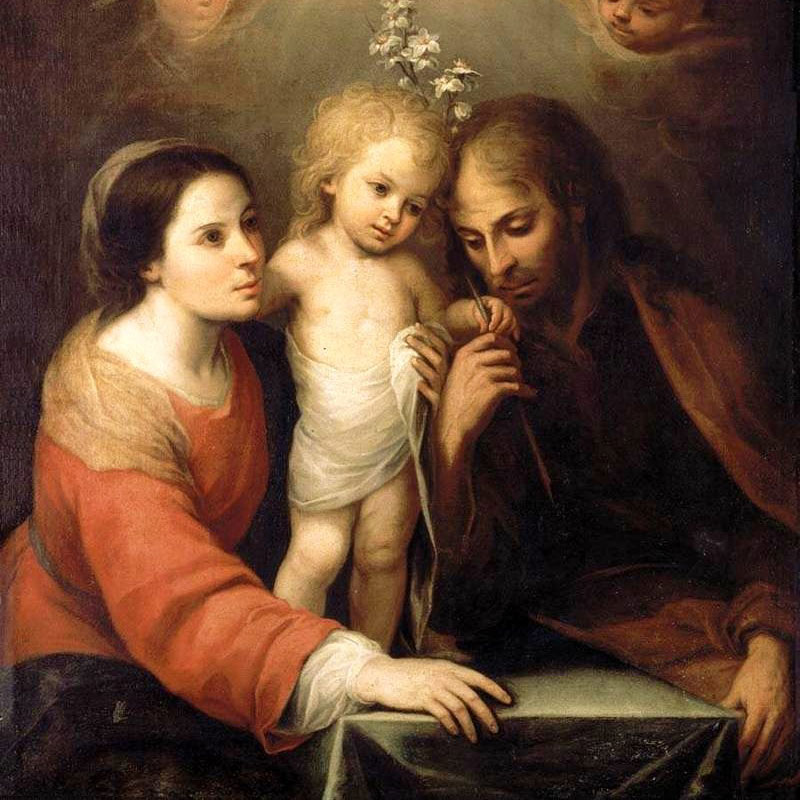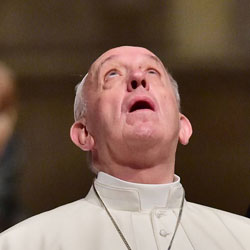The setting of today’s Gospel is like a cross between Lourdes and Las Vegas.
Caesarea Philippi is like Lourdes because there was a grotto and spring there, which was a place of pilgrimage. The Greeks built a pagan Temple dedicated to Pan at the grotto.
Caesarea Philippi is like Las Vegas because it was a place of outrageous excess. Immoral rituals occurred in the temple sanctuary. Sacrifices were thrown into the cave. If victims disappeared into the water, that was a sign that Pan had accepted the sacrifice. But if blood from the sacrifice turned the spring red, that was a sign of Pan’s displeasure.
For all these reasons, “Pan’s Grotto” was also known as “the Gates of Hell,” or a portal into the underworld.
So that’s the setting of today’s Gospel. Our Lord obviously planned this interaction with his disciples. “Who do people say the Son of Man is?” he asks. But he probably wasn’t very interested in the answer. That was just a lead in to his second question. “Who do you say I am?”
Peter gets it right! So Jesus then makes one of those divine calls which resonate down the ages — as significant as God’s covenant with Abraham, and His Law given to Moses.
“You are Peter and on this rock I will build my –”
We know how it finishes. Jesus doesn’t say, “I will build my Temple.” He doesn’t say, “I will build my Synagogue.” But in that same spirit, nor does he say, “I will build my Church.” In this instance, the English language betrays our Lord’s meaning.
What our Lord actually says is, “You are Peter and on this rock I will build my ἐκκλησία.” “My gathering of people.” “My popular movement.”
It’s an important distinction. A growing movement has to grow and has to move. But the very human response is to build walls which contain that movement. So maybe there’s some psychological explanation to the English translation of ἐκκλησία. “Church” doubles as our Lord’s assembly, and the buildings in which they gather. Strictly speaking, an ἐκκλησία is a constant work in progress, but a church is a finished structure.
This contrast was underlined at an Evangelisation conference I’ve just returned from. The whole focus of the conference was on the parish. How to inspire the churched. How to attract the unchurched. How to rebuild our Lord’s popular movement.
The conference was attended by 500 people from all over the country. Nearly ten per cent of those people came from parishes in the Ballarat diocese. This is a huge investment of people, time and money from a small diocese.
This week’s conference showed how we can arrest the Church’s decline, and get the movement growing again. In the weeks and months ahead, you’ll hear how we can do this at a parish level. You and I need only look around this church to see one symptom of the decline. There’s lots of empty pews.
We can look at our own families and see something similar. There we find people whom we love, people whom Our Lord loves, people who love our Lord, but they’re not going to Mass. It’s discouraging. It’s disheartening. It can foster something like the Church’s decline in our own hearts.
But today’s Gospel reminds us that the Church Jesus built isn’t about walls and structures. It’s a popular movement. A work in progress. And the gates of the underworld can never hold out against it.






It is good to hear such a big representation to the conference from the Ballarat Diocese. Hopefully they will bear much fruit in the coming months when they share what they have learnt. I will be looking forward very much to hearing about ideas on how we can encourage Catholics to come home to their church. John is right empty pews speaks volumes and can cause one to feel sad, especially when family have turned away from their faith. I pray all the times for new vocations to the church and that my family will return to their faith one day. I hold onto St Monica praying for her son Augustine to return to his faith and now he is a saint.
The Church in what Christ said, “I will build my church” has never been interpreted as an edifice. It is the mystical body of Christ in his Church Militant. That Body of Christ consist of all the baptized as cells comprising that body.
And it is not a movement that allows new ideas to take root as if it must evolve with the times. Remember that the Church in indefectible. The reason why there are fewer people in the pews is not because the Church needs to become some movement. The reason is because it has abandoned its obligation to educate the flock. So often, ignorant or lukewarm Sunday catholics would support contraceptives, women in church, gay rights, abortion, and other abominable ideas because they have never been schooled enough to understand what the Church teaches. They were merely baptized catholics, and many of them will die as something else. So often, they joint cults, some christian sect, or follow unapproved seers with heretical private revelations, and disparage church authorities because some priests have been found out as pederasts and rapists and do not know their obligations or the church stand on erring priests. The Pope should fire the members of the Vatican’s Congregation for Catholic Education for its monumental failure to teach the flock.
I agree with you a lot Alex, but I disagree with a lot too.
The Church is mistaken for an edifice for sure. Constantly and consistently, including in my own mind. Like I said, that’s human nature.
But is innovation the key to success? Absolutely not. You’re spot on there. I think — and I’m sure you’d agree — that the crazy experimentation and abandonment of Tradition in recent decades has devastated people’s faith.
On the other hand, I don’t think that devastation can be reduced to one cause — unless the cause is satanic. I don’t think the Vatican’s Congregation for Catholic Education — or the curia at large — has the influence you think it has.
The remedy has to come from the ground up. The Church — and the world — needs saints, and lots of them. That’s the solution. Catechesis is part of that, but prayer and sanctification is the heart of it.
That’s where we differ. To me, it must start from the top down. Or at the very least, meet halfway.
(1) When Catholic schools are run like business, the church effectively abandons the training of young minds. It is like merchants and hawkers peddling in the temple of God – the same situation where an angry Christ overturned their tables.
(2) Even religion teachers don’t know their catechism much less canon law. Why can’t the church create a licensing board for religion teachers. There is so much to learn about catechism and canon law. It is no different from learning nursing, law, engineering or medicine which are profession that require licencing. And yet you have ordinary teachers tasked with it and no proof of their competence.
(3) The Vatican dopes not even fund EWTN, considered the most successful catholic TV network. What films or TV shows has the Vatican produced that can claim popular following that can harness the communication power of the media as a means to evangelize?
Just as Faith without good works is worthless in the eyes of God, Prayer is worthless without ACTION. God will not provide divine intervention or a miracle if you do not use the capacities that God has given you. YOu would be a sloth if you did, merely relying on prayers to achieve your ends, and doing nothing.
Catechism may be just a part of the solution. But boy it is a very large part. You cannot expect people to be saints when they don’t even know the 6 deadly sins against the Holy Spirit. That’s like telling the science community that we need a lot of Einsteins when only a few of them even know their quantum physics.
And has any priest even explained to the their flock what the Vatican II Council is? Or even explained to them that taking communion by the hand has never been explicitly espoused by the Church? Or that lay ministers are not supposed to administer the body of Christ except in extreme situations only? Many have abandoned the church because they have embraced the BS of Sedevacantists and Traditionalists who claim the Pope since John 23rd has already started the predicted Great Apostasy.
Amen. Amen and Amen to Alex Lim’s post.
No new program is needed, nor any more bright ideas. All that is needed to revive Catholic practice is priests who preach the true gospel, not some sugary, meaningless pap. Who hear confessions – every day. Who pray the black and do the red in the Holy Sacrifice of the Mass. Who strive to be holy; because a holy priest can work miracles among his flock. Oh yes, add Adoration and the Rosary; preferably with the priest participating if at all possible.
The reason people are not in the Churches is because of the culture of banality and because 97% of kids leave (if they were ever part of) Catholicism, because they are vaccinated against true Catholicism, delivered to them by teachers who don’t have the faith themselves.
Was it St John Eudes who said, “The worst chastisement God can visit on His people is bad priests?”
Your generation of priests gives us hope, Fr John, but you haven’t got control of the switch points. Yet. Meanwhile, it is incumbent on us lay people to pray and make sacrifices for our priests. `
I am particularly upset today after watching young women clad in skin-tight jeans climbing the steps up to the lectern to read at Mass. I think they think this is what they are SUPPOSED to wear for this liturgical duty.
God help us all.
I would like to add somthing to this interesting discussion. If one is talking about Catechesis education, it needs to be taught primarily by the parents to their children. in days gone by when the Church was flourishing in Australia, nuns and priests were teaching children in the Catholic school system, parents became slack with teaching their children the faith and left it up to the Catholic School system, the faith became sterile and emotionless, when the faith is not taught primarily at home and supported by the Catholic Schools, Children do not take it seriously, thus we have generations who have all but lost the faith entirely. We need to pray for our Priests so they have the courage to preach the Gospel and the teachings of the Church in its entirety, and that practicing Catholics have the full support of the Catholic education system, not just a wishy washy proddy version of the Catholic faith. Another thing that needs to happen is for the old on your knees to avoid the fees mentality we have within the Catholic education system, we need to inform parents who want to have their Children Baptised know the serious importance of educating their children in the faith, and this means fulfilling ones Sunday obligation, as well as frequent Confession. nothing annoys me more than seeing the Church full when children are doing sacrements and then never seeeing them set foot inside the Church again.
I totally talked about this blog entry in my Yr 12 RE class the other day, Thanks Fr!!